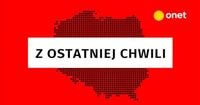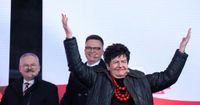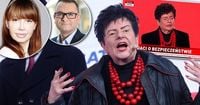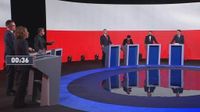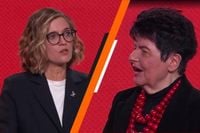On April 11, 2025, a presidential debate held in Końskie captured the attention of viewers not only for the candidates' speeches but also for their contrasting styles. Among the candidates, Joanna Senyszyn stood out with her unconventional attire, featuring a down jacket, jeans, and striking red beads, which sparked discussions and debates among experts and attendees alike.
Senyszyn, a candidate for the presidency of Poland, made her entrance at the debate organized by TV Republika, arriving late and donning a puffy jacket that clashed with the more formal attire of her fellow candidates, who were clad in suits and ties. Her outfit drew immediate attention, leading to varied reactions from experts in communication and fashion.
Maurycy Seweryn, a body language expert, critiqued Senyszyn’s choice of clothing, stating, "The element that is very unfavorable for Ms. Senyszyn, but realistically provoked by her, is the outfit. All other candidates, except for Mr. Krzysztof Stanowski and Ms. Senyszyn, are dressed elegantly, showing respect for the audience and the format of the debate. However, Ms. Senyszyn and Mr. Stanowski are dressed casually, like ordinary mortals. If that was the intention of the campaign, then fine. But if it is the result of not working on oneself and uncontrolled actions, it is perceived negatively."
Stylist Ewa Rubasińska-Ianiro offered a different perspective, suggesting that Senyszyn's outfit was a deliberate performance rather than a misstep. "The outfit is very appropriate for what she was saying, as she was poking fun at other candidates when they promised to do everything in six months. It seems to me that this was more of a performance than a serious debate appearance. Ms. Joanna is simply being herself, just as she presents herself every day in parliament. It’s true that it’s not the attire for a serious debate. But it's very feminine, and the red beads reference Polish folklore. It looks like she planned such a casual vibe," Rubasińska-Ianiro remarked.
During the debate, Senyszyn confronted fellow candidate Magdalena Biejat regarding the coalition government they both belong to. She questioned, "How is it to eat jams that the government gives, and at the same time make arrangements with the president and encourage him to veto the law passed by the coalition in which you are?" This pointed inquiry highlighted the tensions within the leftist candidates as they grappled with their party's role in the current government.
Biejat defended the Left's presence in the government, citing significant achievements such as the widow's pension, changes to the definition of rape, and additional support for parents of premature babies. She asserted, "The Left is needed in this government because thanks to the Left, projects have been implemented that otherwise would not have come to fruition at all. Yes, sometimes some battles are lost. That’s true. But I prefer to lose a battle sometimes while trying to achieve as much as possible for ordinary people. I work on fulfilling the program that I promised to implement here and now."
Senyszyn also entered the discussion about the migration pact, asserting its necessity to ensure order. Her statement was met with booing and hissing from the audience, which demonstrated the divisive nature of the topic. "The migration pact is necessary because only the migration pact will ensure order. Otherwise, immigrants will still come, but there will be no order. Other countries will send us migrants, but there will be no order. If we want everything to be organized, a pact is needed. This does not mean, however, that it must be accepted in its current form; negotiations are necessary," Senyszyn stated.
The debate also featured other candidates, including Karol Nawrocki, Szymon Hołownia, and Marek Jakubiak. Nawrocki expressed his opposition to the migration pact, emphasizing the importance of maintaining control over immigration policies. Hołownia added that Poland had already taken in two million refugees from Ukraine and that every community has its capacity for accepting newcomers from other regions.
In a surprising exchange, Maciej Maciak questioned Senyszyn about her reasons for running for president, considering the presence of other leftist candidates. "I am running so I have someone to vote for, because none of the other candidates appeal to me, and I believe many voters share my views," she replied. Senyszyn emphasized that she plans to address issues that other candidates avoid due to their discomfort, asserting her expertise as a professor of economics will guide her decisions on future legislation.
Senyszyn's unexpected entrance into the debate stirred emotions among the audience, with some expressing surprise and admiration. Her assertive remarks and distinct style set her apart from her counterparts, who were more traditionally attired. As the debate progressed, it became clear that her approach was both a statement and a strategy, one that resonated with a segment of the electorate seeking authenticity and a break from the norm.
As the presidential elections approach, scheduled for May 18, 2025, with a potential second round on June 1, the dynamics among candidates are likely to evolve further. The debates serve not only as a platform for policy discussion but also as a reflection of the candidates' personalities and their connection with the public.
In conclusion, Joanna Senyszyn's performance in the Końskie debate illustrates the complex interplay of image, messaging, and political strategy in the lead-up to the presidential elections. With her unique style and candid approach, she has positioned herself as a formidable candidate who is unafraid to challenge the status quo and engage in the pressing issues facing Poland today.
